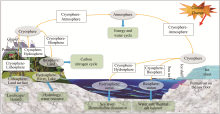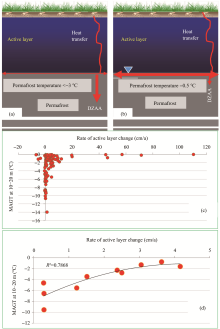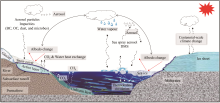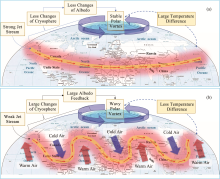Sciences in Cold and Arid Regions ›› 2020, Vol. 12 ›› Issue (6): 329–342.doi: 10.3724/SP.J.1226.2020.00329
A review of the interaction between the cryosphere and atmosphere
YongJian Ding1,2,3,JianPing Yang1( ),ShengXia Wang2,YaPing Chang2
),ShengXia Wang2,YaPing Chang2
- 1.State Key Laboratory of Cryospheric Science, Northwest Institute of Eco-Environment and Resources, Chinese Academy of Sciences, Lanzhou, Gansu 730000, China
2.China -Pakistan Joint Research Center on Earth Science, CAS-HEC, Islamabad, Pakistan
3.University of Chinese Academy of Sciences, Beijing 100049, China
|
Allen RJ, Zender CS, 2011. Forcing of the Arctic Oscillation by Eurasian snow cover. Journal of Climate, 24: 6528-6539. DOI: 10.1175/2011JCLI4157.1.
doi: 10.1175/2011JCLI4157.1 |
|
| AMAP, 2017. Snow, Water, Ice and Permafrost in the Arctic (SWIPA) 2017. Arctic Monitoring and Assessment Programme (AMAP), Oslo, Norway, pp. 269. | |
|
Aoki T, Hachikubo A, Hori M, 2003. Effects of snow physical parameters on shortwave broadband albedos. Journal of Geophysical Research-Atmospheres, 108: 4616. DOI: org/10.1029/2003JD003506.
doi: org/10.1029/2003JD003506 |
|
|
Atlaskina K, Berninger F, de Leeuw G, 2015. Satellite observations of changes in snow-covered land surface albedo during spring in the Northern Hemisphere. The Cryosphere, 9: 1879-1893. DOI: org/10.5194/tc-9-1879-2015.
doi: org/10.5194/tc-9-1879-2015 |
|
|
Bakker P, Clark PU, Golledge NR, et al., 2016. Centennial-scale holocene climate variations amplified by Antarctic ice sheet discharge. Nature, 541(7635): 72-76. DOI: 10. 1038/nature20582.
doi: 10. 1038/nature20582 |
|
|
Blackport R, Screen JA, 2019. Influence of Arctic sea ice loss in autumn compared to that in winter on the atmospheric circulation. Geophysical Research Letters, 46(4): 2213-2221. DOI: 10.1029/2018gl081469.
doi: 10.1029/2018gl081469 |
|
|
Blackport R, Screen JA, van der Wiel K, et al., 2019. Minimal influence of reduced Arctic sea ice on coincident cold winters in mid-latitudes. Nature Climate Change, 9: 697-704. DOI: org/10.1038/s41558-019-0551-4.
doi: org/10.1038/s41558-019-0551-4 |
|
| Box JE, Colgan WT, 2017. Sea level rise contribution from Arctic land ice: 1850-2100. In: Snow, Water, Ice and Permafrost in the Arctic (SWIPA)2017. | |
| Arctic Monitoring and Assessment Programme (AMAP), Oslo, Norway, pp. 220-231. | |
|
Boy M, Thomson ES, Acosta NJC, et al., 2019. Interactions between the atmosphere, cryosphere and ecosystems\rat northern high latitudes. Atmospheric Chemistry and Physics, 19: 2015-2061. DOI: org/10.5194/acp-19-2015-2019.
doi: org/10.5194/acp-19-2015-2019 |
|
| Brown R, Schuler DV, Bulygina O, et al., 2017. Arctic terrestrial snow cover. In: Snow, Water, Ice and Permafrost in the Arctic (SWIPA)2017. | |
| Arctic Monitoring and Assessment Programme (AMAP), Oslo, Norway. pp. 26-63. | |
|
Callaghan TV, Johansson M, Key J, et al., 2011. Feedbacks and interactions: from the Arctic Cryosphere to the climate system. Ambio, 40(s1): 75-86. DOI:10.1007/s13280-011-0215-8.
doi: 10.1007/s13280-011-0215-8 |
|
| Chen RS, Zhang SQ, Yang Y, et al., 2019. The Effects of Cryosphere Change on Stream Runoff in Cold Regions of Western China. Beijing: Science Press. | |
|
Cohen J, Entekhabi D, 1999. Eurasian snow cover variability and Northern Hemisphere climate predictability. Geophysical Research Letters, 26: 345-348. DOI:10.1029/1998gl900321.
doi: 10.1029/1998gl900321 |
|
|
Cohen J, Screen JA, Furtado JC, et al., 2014. Recent Arctic amplification and extreme mid-latitude weather. Nature Geoscience, 7: 627-637. DOI: 10.1038/ngeo2234.
doi: 10.1038/ngeo2234 |
|
|
Cohen J, Zhang X, Francis J, et al., 2020. Divergent consensuses on Arctic amplification influence on midlatitude severe winter weather. Nature Climate Change, 10: 20-29. DOI: org/10.1038/s41558-019-0662-y.
doi: org/10.1038/s41558-019-0662-y |
|
|
Cohen JL, Furtado JC, Barlow MA, et al., 2012. Arctic warming, increasing snow cover and widespread boreal winter cooling. Environmental Research Letters, 7: 014007. DOI: 10.1088/1748-9326/7/1/014007.
doi: 10.1088/1748-9326/7/1/014007 |
|
|
Coumou D, Di Capua G, Vavrus S, et al., 2018. The influence of Arctic amplification on mid-latitude summer circulation. Nature Communications, 9: 2959. DOI: org/10.1038/s41467-018-05256-8.
doi: org/10.1038/s41467-018-05256-8 |
|
|
Cvijanovic I, Caldeira K, 2015. Atmospheric impacts of sea ice decline in CO2 induced global warming. Climate Dynamics, 44: 1173-1186. DOI: org/10.1007/s00382-015-2489-1.
doi: org/10.1007/s00382-015-2489-1 |
|
|
Dagsson WP, Meinander O, 2019. Editorial: atmosphere-cryosphere interaction in the Arctic, at high latitudes and mountains with focus on transport, deposition, and effects of dust, black carbon, and other aerosols. Frontiers in Earth Science, 7(337): 1-4. DOI: 10.3389/feart.2019.00337.
doi: 10.3389/feart.2019.00337 |
|
|
Dai A, Luo D, Song M, et al., 2019. Arctic amplification is caused by sea-ice loss under increasing CO2. Nature Communications, 10(1): 1-7. DOI: org/10.1038/s41467-018-07954-9.
doi: org/10.1038/s41467-018-07954-9 |
|
|
Dai A, Song M, 2020. Little influence of Arctic amplification on mid-latitude climate. Nature Climate Change, 10: 231-237. DOI: org/10.1038/s41558-020-0694-3.
doi: org/10.1038/s41558-020-0694-3 |
|
| Derksen C, Brown R, Mudryk L, et al., 2015.The Arctic-terrestrial snow cover [in "State of the Climate in 2014"]. Bulletin of the American Meteorological Society, Special supplement, 96(7): S133-S135. | |
|
Ding YJ, 1996. Global glacial fluctuations in response to climatic change in the past 40a. Science in China (Series D), 39(1): 66-73. DOI: CNKI:SUN:JDXG.0.1996-01-007.
doi: CNKI:SUN:JDXG.0.1996-01-007 |
|
| Ding YJ, Mu M, Lin ED, 2012. Climate and environment evolution in China: 2012- impacts and vulnerability. In: Qin DH, Domg YJ, Mu M (eds.). Climate and Environmental Evolution in China: 2012. Beijing: China Meteorological Press. | |
|
Ding YJ, Xiao CD, 2013. Challenges in the study of cryospheric changes and their impacts. Advances in Earth Science, 28(10): 1067-1076. DOI: CNKI:SUN:DXJZ.0.2013-10-001.
doi: CNKI:SUN:DXJZ.0.2013-10-001 |
|
|
Ding YJ, Zhang SQ, 2018. Study on water internal recycle process and mechanism in typical mountain areas of inland basins, northwest China: Progress and challenge. Advances in Earth Science, 33(7): 70-78. DOI: 10.11867/j.issn.1001-8166.2018.07.0.
doi: 10.11867/j.issn.1001-8166.2018.07.0 |
|
| Ding YJ, Zhang SQ, Chen RS, 2017. Hydrological Introduction in the Cold Regions. Beijing: Science Press. | |
|
Ding YJ, Zhang SQ, Zhao L, et al., 2019. Global warming weakening the inherent stability of glaciers and permafrost. Science Bulletin, 64: 245-253. DOI: 10.1016/j.scib.2018. 12.028.
doi: 10.1016/j.scib.2018. 12.028 |
|
|
Domine F, Salvatori R, Legagneux L, et al., 2006. Correlation between the specific surface area and the short wave infrared (SWIR) reflectance of snow. Cold Regions Science and Technology, 46: 60-68. DOI: 10.1016/j.coldregions.2006. 06.002.
doi: 10.1016/j.coldregions.2006. 06.002 |
|
| Field CB, Barros VR, Mach KJ, et al., 2014. Technical summary. In:Climate Change2014: Impacts, Adaptation, and Vulnerability. Part A: Global and Sectoral Aspects. IPCC AR5. In: Fieldet al. (eds.. | |
| Cambridge, United Kingdom and New York, NY, USA: Cambridge University Press, pp. 35-94. | |
|
Fletcher CG, Hardiman SC, Kushner PJ, et al., 2009. The dynamical response to snow cover perturbations in a large ensemble of atmospheric GCM integrations. Journal of Climate, 22: 1208-1222. DOI: 10.1175/2008JCLI2505.1.
doi: 10.1175/2008JCLI2505.1 |
|
|
Francis D, Eayrs C, Chaboureau J, et al., 2018. Polar Jet associated circulation triggered a Saharan Cyclone and derived the poleward transport of the African Dust generated by the cyclone. Journal of Geophysical Research: Atmospheres, 123(21): 11899-11917. DOI: org/10.1029/2018JD029095.
doi: org/10.1029/2018JD029095 |
|
| Francis JA, 2018. Clarity and Clouds: Progress in Understanding Arctic Influences on Mid-latitude Weather. In Arctic Report Card2018. Online at:. | |
|
Francis JA, Vavrus SJ, 2012. Evidence linking Arctic amplification to extreme weather in mid-latitudes. Geophysical Research Letters, 39: L06801. DOI: 10.1029/2012GL051000.
doi: 10.1029/2012GL051000 |
|
|
Francis JA, Vavrus SJ, 2015. Evidence for a wavier jet stream in response to rapid Arctic warming. Environmental Research Letters, 10: 014005. DOI: 10.1088/1748-9326/10/1/014005.
doi: 10.1088/1748-9326/10/1/014005 |
|
| French H, Slaymaker O, 2012. Changing Cold Environments: A Canadian Perspective. Wiley-Blackwell. | |
|
Furtado JC, Cohen JL, Tziperman E, 2016. The combined influences of autumnal snow and sea ice on Northern Hemisphere winters. Geophysical Research Letters, 43: 3478-3485. DOI: 10.1002/2016gl068108.
doi: 10.1002/2016gl068108 |
|
|
Groot Zwaaftink CD, Grythe H, Skov H, et al., 2016. Substantial contribution of northern high-latitude sources to mineral dust in the Arctic. Journal of Geophysical Research: Atmospheres, 121(22): 13678-13697. DOI: org/10.1002/2016JD025482.
doi: org/10.1002/2016JD025482 |
|
|
Guo D, Gao Y, Bethke I, et al., 2014. Mechanism on how the spring Arctic sea ice impacts the East Asian summer monsoon. Theoretical and Applied Climatology, 115: 107-119. DOI: org/10.1007/s00704-013-0872-6.
doi: org/10.1007/s00704-013-0872-6 |
|
|
Hall JV, Loboda TV, 2017. Quantifying the potential for low-level transport of black carbon emissions from cropland burning in Russia to the snow-covered arctic. Frontiers in Earth Science, 5: 109. DOI: 10.3389/feart.2017.00109.
doi: 10.3389/feart.2017.00109 |
|
|
Hudson SR, 2011. Estimating the global radiative impact of the sea ice-albedo feedback in the Arctic. Journal of Geophysical Research-Atmospheres, 116: D16102. DOI: org/10.1029/2011JD015804.
doi: org/10.1029/2011JD015804 |
|
| IPCC, 2007. Climate change 2007: Impacts,adaptation and vulnerability. Contribution of Working Group II to the Fourth Assessment Report of the Intergovernmental Panel on Climate Change. Cambridge, UK and New York, USA: Cambridge University Press. | |
|
Jolly MW, Cochrane MA, Freeborn PH, et al., 2015. Climate-induced variations in global wildfire danger from 1979 to 2013. Nature Communications, 6: 7537. DOI: 10.1038/ncomms8537.
doi: 10.1038/ncomms8537 |
|
|
Kim I, Amita P, Oh Jaiho, et al., 2020. Combined impact of Greenland sea ice, Eurasian snow, and El Niño-Southern Oscillation on Indian and Korean summer monsoons. The International Journal of Climatology, 40(3): 1375-1395. DOI: org/10.1002/joc.6275.
doi: org/10.1002/joc.6275 |
|
|
Kim Y, Kimball JS, Zhang K, et al., 2014. Attribution of divergent northern vegetation growth responses to lengthening non-frozen seasons using satellite optical-NIR and microwave remote sensing. International Journal of Remote Sensing, 35: 3700-3721. DOI: org/10.1080/01431161.2014. 915595.
doi: org/10.1080/01431161.2014. 915595 |
|
|
Kretschmer M, Coumou D, Agel L, et al., 2018. More persistent weak stratospheric polar vortex states linked to cold extremes. Bulletin of the American Meteorological Society, 99: 49-60. DOI: 10.1175/BAMS-D-16-0259.1.
doi: 10.1175/BAMS-D-16-0259.1 |
|
|
Kretschmer M, Coumou D, Donges JF, et al., 2016. Using causal effect networks to analyze different Arctic drivers of mid-latitude winter circulation. Journal of Climate, 29: 4069-4081. DOI: 10.1175/JCLI-D-15-0654.1.
doi: 10.1175/JCLI-D-15-0654.1 |
|
|
Kug JS, Jeong JH, Jang YS, et al., 2015. Two distinct influences of Arctic warming on cold winters over North America and East Asia. Nature Geoscience, 8: 759-762. DOI: org/10.1038/ngeo2517.
doi: org/10.1038/ngeo2517 |
|
|
Leclercq PW, Oerlemans J, Cogley JG, 2011. Estimating the glacier contribution to sea-level rise for the period 1800-2005. Surveys in Geophysics, 32: 519-535. DOI:10.1007/s10712-0119121-7.
doi: 10.1007/s10712-0119121-7 |
|
|
Levermann A, Bamber JL, Drijfhout S, et al., 2012. Potential climatic transitions with profound impact on Europe: Review of the current state of six 'tipping elements of the climate system'. Climatic Change, 110: 845-878. DOI: 10. 1007/s10584-011-0126-5.
doi: 10. 1007/s10584-011-0126-5 |
|
|
Li D, Li T, Jiang H, et al., 2018. East Asian winter monsoon variations and their links to Arctic sea ice during the last millennium, inferred from sea surface temperatures in the Okinawa Trough. Paleoceanography and Paleoclimatology, 33: 61-75. DOI: org/10.1002/2016PA003082.
doi: org/10.1002/2016PA003082 |
|
|
Li F, Wang H, 2013. Relationship between Bering Sea ice cover and East Asian winter monsoon year-to-year variations. Advances in Atmospheric Sciences, 30: 48-56. DOI: org/10.1007/s00376-012-2071-2.
doi: org/10.1007/s00376-012-2071-2 |
|
|
Li HL, Wang HJ, Jiang DB, 2017. Influence of october eurasian snow on winter temperature over Northeast China. Advances in Atmospheric Sciences, 34(1): 116-126. DOI: 10.1007/s00376-016-5274-0.
doi: 10.1007/s00376-016-5274-0 |
|
|
Li W, Guo W, Qiu B, et al., 2018. Influence of Tibetan Plateau snow cover on East Asian atmospheric circulation at medium-range time scales. Nature Communications, 9: 4243. DOI: org/10.1038/s41467-018-06762-5.
doi: org/10.1038/s41467-018-06762-5 |
|
|
Lu ZZ, He SP, Li F, et al., 2019. Impacts of the Autumn Arctic Sea Ice on the Intraseasonal Reversal of the Winter Siberian High. Advances in Atmospheric Sciences, 36(2): 173-188. DOI: org/10.1007/s00376-017-8089-8.
doi: org/10.1007/s00376-017-8089-8 |
|
|
Mann ME, Rahmstorf S, Kornhuber K, et al., 2017. Influence of anthropogenic climate change on planetary wave resonance and extreme weather events. Scientific Reports, 7: 45242. DOI: 10.1038/srep45242.
doi: 10.1038/srep45242 |
|
| Mård J, Box Jason E, Ross Brown, et al., 2017. Cross-cutting scientific issues. In: Snow, Water, Ice and Permafrost in the Arctic (SWIPA)2017. | |
| Arctic Monitoring and Assessment Programme (AMAP), Oslo, Norway. pp. 232-252. | |
|
Marzeion B, Cogley JG, Richter K, et al., 2014a. Attribution of global glacier mass loss to anthropogenic and natural causes. Science, 345: 919-921. DOI: 10.1126/science. 1254702.
doi: 10.1126/science. 1254702 |
|
|
Marzeion B, Jarosch AH, Gregory JM, 2014b. Feedbacks and mechanisms affecting the global sensitivity of glaciers to climate change. The Cryosphere, 8: 59-71. DOI: 10.5194/tc-8-59-2014.
doi: 10.5194/tc-8-59-2014 |
|
|
Marzeion B, Jarosch AH, Hofer M, 2012. Past and future sea level change from the surface mass balance of glaciers. The Cryosphere, 6: 1295-1322. DOI: 10.5194/tc-6-1295-2012.
doi: 10.5194/tc-6-1295-2012 |
|
|
McCusker KE, Fyfe JC, Sigmond M, 2016. Twenty-five winters of unexpected Eurasian cooling unlikely due to Arctic sea ice loss. Nature Geoscience, 9: 838-842. DOI: 10.1038/NGEO2820.
doi: 10.1038/NGEO2820 |
|
|
McCusker KE, Kushner PJ, Fyfe JC, et al., 2017. Remarkable separability of circulation response to Arctic sea ice loss and greenhouse gas forcing. Geophysical Research Letters, 44: 7955-7964. DOI: 10.1002/2017GL074327.
doi: 10.1002/2017GL074327 |
|
|
Meinander O, Kazadzis S, Arola A, et al., 2013. Spectral albedo of seasonal snow during intensive melt period at Sodankylä, beyond the Arctic Circle. Atmospheric Chemistry and Physics, 13: 3793-3810. DOI: org/10.5194/acp-13-3793-2013.
doi: org/10.5194/acp-13-3793-2013 |
|
|
Meleshko VP, Johannessen OM, Baidin AV, et al., 2016. Arctic amplification: does it impact the polar jet stream? Tellus, 68: 32330.1-32330.11. DOI: org/10.3402/tellusa.v68.32330.
doi: org/10.3402/tellusa.v68.32330 |
|
|
Mori M, Kosaka Y, Watanabe M, et al., 2019. A reconciled estimate of the influence of Arctic sea-ice loss on recent Eurasian cooling. Nature Climate Change, 9: 123-129. DOI: org/10.1038/s41558-018-0379-3.
doi: org/10.1038/s41558-018-0379-3 |
|
| Mori M, Watanabe M, Shiogama H, et al., 2014. Robust Arctic sea-ice influence on the frequent Eurasian cold winters in past decades. Nature Geoscience, 7: 869-873. DOI.org/10.1038/ngeo2277. | |
|
Norris SJ, Brooks IM, de Leeuw G, et al., 2011. Measurements of bubble size spectra within leads in the Arctic summer pack ice. Ocean Science, 7: 129-139. DOI: org/10.5194/os-7-129-2011.
doi: org/10.5194/os-7-129-2011 |
|
|
Orsolini YJ, Senan R, Vitart F, et al., 2016. Influence of the Eurasian snow on the negative North Atlantic Oscillation in subseasonal forecasts of the cold winter 2009/2010. Climate Dynamics, 47: 1325-1334. DOI: 10.1007/s00382-015-2903-8.
doi: 10.1007/s00382-015-2903-8 |
|
|
Overland JE, Francis JA, Hall R, et al., 2015. The melting Arctic and mid-latitude weather patterns: Are they connected? Journal of Climate, 28: 7917-7932. DOI: 10.1175/JCLI-D-14-00822.1.
doi: 10.1175/JCLI-D-14-00822.1 |
|
|
Overland JE, Wang M, 2010. Large-scale atmospheric circulation changes are associated with the recent loss of Arctic sea ice. Tellus A, 62: 1-9. DOI: 10.1111/j.1600-0870. 2009. 00421.x.
doi: 10.1111/j.1600-0870. 2009. 00421.x |
|
|
Peings Y, Cattiaux J, Vavrus SJ, et al., 2018. Projected squeezing of the wintertime North-Atlantic jet. Environmental Research Letters, 13: 074016. DOI: 10.1088/1748-932/aacc79.
doi: 10.1088/1748-932/aacc79 |
|
|
Perovich DK, Polashenski C, 2012. Albedo evolution of seasonal Arctic sea ice. Geophysical Research Letters, 39: L08501. DOI: org/10.1029/2012GL051432.
doi: org/10.1029/2012GL051432 |
|
|
Petoukhov V, Semenov VA, 2010. A link between reduced Barents-Kara sea ice and cold winter extremes over northern continents. Journal of Geophysical Research, 115: D21111. DOI: 10.1029/2009JD013568.
doi: 10.1029/2009JD013568 |
|
|
Petrie RE, Shaffrey LC, Sutton RT, 2015. Atmospheric response in summer linked to recent Arctic sea ice loss. Quarterly Journal of the Royal Meteorological Society, 141: 2070-2076. DOI: 10.1002/qj.2502.
doi: 10.1002/qj.2502 |
|
|
Pithan F, Mauritsen T, 2014. Arctic amplification dominated by temperature feedbacks in contemporary climate models. Nature Geoscience, 7: 181-184. DOI: org/10.1038/ngeo2071.
doi: org/10.1038/ngeo2071 |
|
|
Qin DH, Ding YJ, Xiao CD, et al., 2018. Cryospheric Science: research framework and disciplinary system. National Science Review, 5(2): 255-268. DOI: 10.1093/nsr/nwx108.
doi: 10.1093/nsr/nwx108 |
|
| Richter-Menge J, Overland JE, Mathis JT, et al. (eds.), 2017. Arctic Report Card2017. Online at:. | |
|
Roe G, Baker M, Herla F, 2016. Centennial glacier retreat as categorical evidence of regional climate change. Nature Geoscience, 10(2): 95-99. DOI: 10.1038/ngeo2863.
doi: 10.1038/ngeo2863 |
|
|
Screen JA, Simmonds I, 2014. Amplified mid-latitude planetary waves favour particular regional weather extremes. Nature Climate Change, 4: 704-709. DOI: 10.1038/nclimate2271.
doi: 10.1038/nclimate2271 |
|
|
Semenov VA, Latif M, 2015. Nonlinear winter atmospheric circulation response to Arctic sea ice concentration anomalies for different periods during 1966-2012. Environmental Research Letters, 10: 054020. DOI: 10.1088/1748-9326/10/5/054020.
doi: 10.1088/1748-9326/10/5/054020 |
|
|
Serreze MC, Barry RG, 2011. Processes and impacts of Arctic amplification: A research synthesis. Global Planet Change, 77: 85-96. DOI: 10.1016/j.gloplacha.2011.03.004.
doi: 10.1016/j.gloplacha.2011.03.004 |
|
|
Shen H, Li F, He S, et al., 2020. Impact of late spring Siberian snow on summer rainfall in South-Central China. Climate Dynamics, 54: 3803-3818. DOI: org/10.1007/s00382-020-05206-5.
doi: org/10.1007/s00382-020-05206-5 |
|
|
Siew PYF, Camille L, Stefan PS, et al., 2019. Intermittency of Arctic-midlatitude teleconnections: stratospheric pathway between autumn sea ice and the winter NAO. Weather and Climate dynamics. DOI: 10.5194/wcd-2019-11.
doi: 10.5194/wcd-2019-11 |
|
|
Steffen K, Yang DQ, Ryabinin V, et al., 2012. ACSYS: A Scientific Foundation for the Climate and Cryosphere (CliC) Project. In: Lemke P, Jacobi HW (eds.). Arctic Climate Change: The ACSYS Decade and Beyond, Atmospheric and Oceanographic Sciences Library, 43. DOI: 10.1007/978-94-007-2027-5_12.
doi: 10.1007/978-94-007-2027-5_12 |
|
|
Sun CH, Yang S, Li WJ, et al., 2016. Interannual variations of the dominant modes of East Asian winter monsoon and possible links to Arctic sea ice. Climate Dynamics, 47(1-2): 481-496. DOI: 10.1007/s00382-015-2851-3.
doi: 10.1007/s00382-015-2851-3 |
|
|
Tang Q, Zhang X, Francis JA, 2014. Extreme summer weather in northern mid-latitudes linked to a vanishing cryosphere. Nature Climate Change, 4: 45-50. DOI: 10.1038/NCLIMATE2065.
doi: 10.1038/NCLIMATE2065 |
|
|
Taylor PC, Cai M, Hu A, et al., 2013. A decomposition of feedback contributions to polar warming amplification. Journal of Climate, 26: 7023-7043. DOI: 10.1175/JCLI-D-12-00696.1.
doi: 10.1175/JCLI-D-12-00696.1 |
|
| Vaughan DG, Comiso JC, Allison IJ, et al., 2013. Observations: Cryosphere. In:Climate Change2013: IPCC AR5. In: Stocker TF, et al. (eds.. | |
| Cambridge University Press, Cambridge, United Kingdom and New York, NY, USA. | |
|
Vavrus SJ, 2018. The influence of Arctic amplification on mid-latitude weather and climate. Current Climate Change Reports, 4: 238-249. DOI: 10.1007/s40641-018-0105-2.
doi: 10.1007/s40641-018-0105-2 |
|
|
Vavrus SJ, Wang F, Martin J, et al., 2017. Changes in North American atmospheric circulation and extreme weather: Influence of Arctic amplification and Northern Hemisphere snow cover. Journal of Climate, 30: 4317-4333. DOI: 10. 1175/JCLI-D-16-0762.1.
doi: 10. 1175/JCLI-D-16-0762.1 |
|
| Wadhams P, 2016. Fairwell to Ice, Penguin Books Ltd., ISBN 9780241009437. | |
|
Wu Z, Zhang P, Chen H, et al., 2016. Can the Tibetan Plateau snow cover influence the interannual variations of Eurasian heat wave frequency? Climate Dynamics, 46: 3405-3417. DOI: org/10.1007/s00382-015-2775-y.
doi: org/10.1007/s00382-015-2775-y |
|
|
Yao Y, Luo D, Dai A, et al., 2017. Increased quasi stationarity and persistence of winter Ural blocking and Eurasian extreme cold events in response to Arctic warming. Part I: Insights from observational analyses. Journal of Climate, 30: 4317-4333. DOI: 10.1175/JCLI-D-16-0261.1.
doi: 10.1175/JCLI-D-16-0261.1 |
|
|
Ye K, 2019. Interannual variability of March snow mass over Northern Eurasia and its relation to the concurrent and preceding surface air temperature, precipitation and atmospheric circulation. Climate Dynamics, 52: 2813-2836. DOI: org/10.1007/s00382-018-4297-x.
doi: org/10.1007/s00382-018-4297-x |
|
|
Ye K, Jung T, Semmler T, 2018. The influences of the Arctic troposphere on the midlatitude climate variability and the recent Eurasian cooling. Journal of Geophysical Research-Atmospheres, 123: 10162-10184. DOI: 10.1029/2018JD028980.
doi: 10.1029/2018JD028980 |
|
|
York A, Bhatt U, Thoman R, et al., 2018. Wildland fire in boreal and arctic North America [in "State of the Climate in 2017"]. Bulletin of the American Meteorological Society, 99(8): S167-S169. DOI: 10.1175/2018BAMSStateoftheClimate.1.
doi: 10.1175/2018BAMSStateoftheClimate.1 |
|
|
You QL, Wu T, Shen LC, et al., 2020. Review of snow cover variation over the Tibetan Plateau and its influence on the broad climate system. Earth Science Reviews, 201: 103043. DOI: org/10.1016/j.earscirev.2019.103043.
doi: org/10.1016/j.earscirev.2019.103043 |
|
|
Young AM, Higuera PE, Duffy PA, et al., 2016. Climatic thresholds shape northern high-latitude fire regimes and imply vulnerability to future climate change. Ecography, 39: 001-012. DOI: 10.1111/ecog, 02205.
doi: 10.1111/ecog |
|
|
Zhang P, Wu Z, Li J, et al., 2020. Seasonal prediction of the northern and southern temperature modes of the East Asian winter monsoon: the importance of the Arctic sea ice. Climate Dynamics, 54: 3583-3597. DOI: org/10.1007/s00382-020-05182-w.
doi: org/10.1007/s00382-020-05182-w |
|
|
Zhang P, Wu Y, Simpson IR, et al., 2018. A stratospheric pathway linking a colder Siberia to Barents-Kara Sea sea ice loss. Science Advances, 4: eaat6025. DOI: 10.1126/sciadv.aat6025.
doi: 10.1126/sciadv.aat6025 |
|
|
Zhang R, Sun C, Zhang R, et al., 2019. Role of Eurasian snow cover in linking winter‐spring Eurasian coldness to the autumn Arctic sea ice retreat. Journal of Geophysical Research: Atmospheres, 124. DOI: org/10.1029/2019JD030339.
doi: org/10.1029/2019JD030339 |
|
|
Zhang RN, Sun CH, Zhu JS, et al., 2020. Increased European heat waves in recent decades in response to shrinking Arctic sea ice and Eurasian snow cover. Climate and Atmospheric Science, 3: 7. DOI: org/10.1038/s41612-020-0110-8.
doi: org/10.1038/s41612-020-0110-8 |
|
|
Zhang RN, Zhang RH, Zuo ZY, 2017. Impact of Eurasian spring snow decrement on East Asian summer precipitation. Journal of Climate, 30: 3421-3437. DOI: 10.1175/JCLI-D-16-0214.1.
doi: 10.1175/JCLI-D-16-0214.1 |
|
|
Zhang TT, Wang T, Gerhard K, et al., 2019. The weakening relationship between Eurasian spring snow cover and Indian summer monsoon rainfall. Science Advances, 5(3): eaau8932. DOI: 10.1126/sciadv.aau8932.
doi: 10.1126/sciadv.aau8932 |
|
|
Zhou W, 2017. Impact of Arctic amplification on East Asian winter climate. Atmospheric and Oceanic Science Letters, 10(5): 385-388. DOI: 10.1080/16742834.2017.1350093.
doi: 10.1080/16742834.2017.1350093 |
| No related articles found! |








